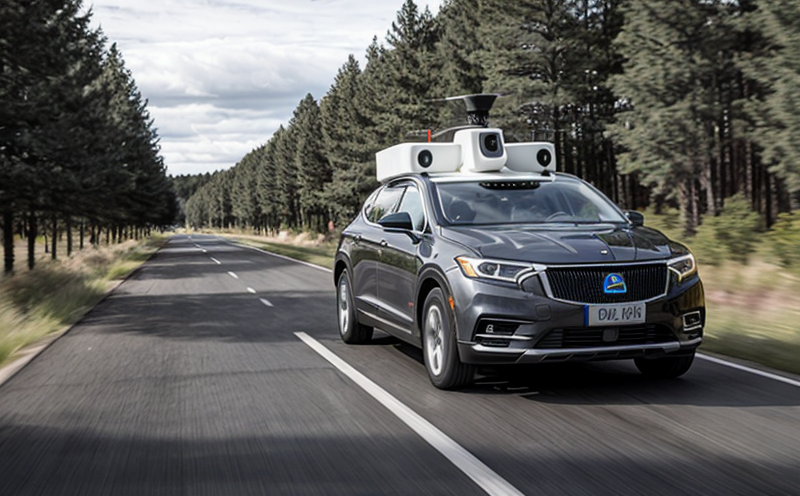UL 1740 Industrial Robot Navigation Safety Assessment
The UL 1740 standard provides a comprehensive framework for assessing safety in industrial robot navigation systems. This assessment is critical as it ensures that robots can safely navigate complex environments, interact with other machines and personnel, and operate within safe boundaries without posing risks of injury or damage.
UL 1740 covers various aspects including collision avoidance, proximity detection, and safe operation in shared workspaces. Compliance with this standard is essential for manufacturers aiming to meet international safety standards and ensure their products are suitable for use in collaborative environments.
The standard applies to industrial robots designed to operate within a defined space where human workers may also be present. The assessment focuses on the robot's ability to detect obstacles, adjust its trajectory, and avoid collisions with both stationary and moving objects. This ensures that the robot can function safely alongside humans without causing harm or disruption.
UL 1740 addresses several key areas:
- Collision Detection
- Safe Operating Distance
- Collision Avoidance Algorithms
- Human-Robot Interaction Protocols
- Error Handling and Recovery Mechanisms
- Environmental Adaptability
The assessment process involves multiple stages, including initial design review, prototype testing, field trials, and final certification. Each stage ensures that the robot meets the stringent safety requirements set forth by UL 1740.
Design Review: This phase includes a thorough examination of the robot's architecture to identify potential hazards. Engineers analyze how the robot interacts with its environment and other systems, ensuring all components are designed for safe operation.
Prototype Testing: Once the design is validated, prototypes undergo rigorous testing using real-world scenarios. This helps in identifying any issues that might arise during actual use. The tests cover various aspects such as obstacle detection, response time, and failure modes.
Field Trials: After successful prototype testing, field trials are conducted to evaluate the robot's performance under different conditions. These trials provide valuable insights into how the robot behaves in real-world situations, helping manufacturers refine their products further.
Certification: Upon satisfactory completion of all stages, certification is issued by UL. This certification signifies that the product meets the stringent safety requirements set forth by the standard and can be used safely in shared workspaces.
Why It Matters
The importance of UL 1740 cannot be overstated, especially given the increasing trend towards collaborative robotics. As robots become more integrated into manufacturing processes, there is a growing need for robust safety measures to protect both workers and equipment.
Compliance with this standard ensures that industrial robots can safely navigate complex environments without causing harm. This not only enhances productivity but also improves workplace safety by reducing the risk of accidents involving human-robot interactions.
In addition, UL 1740 helps manufacturers meet regulatory requirements in various regions around the world. Many countries have adopted similar standards to ensure that industrial robots are safe for use in shared workspaces. By adhering to these standards, manufacturers can expand their markets and gain a competitive edge.
Furthermore, compliance with UL 1740 demonstrates a commitment to excellence and reliability. It builds trust among customers who value safety above all else. This can lead to increased customer satisfaction and loyalty, ultimately driving business growth.
Scope and Methodology
| Aspect | Description |
|---|---|
| Collision Detection | The robot must be capable of detecting obstacles within its operational range. |
| Safe Operating Distance | The robot should maintain a safe distance from humans and other equipment during operation. |
| Collision Avoidance Algorithms | The robot’s navigation system must include algorithms that ensure safe movement in shared workspaces. |
| Human-Robot Interaction Protocols | Procedures for interaction between the robot and human workers must be defined and tested. |
| Error Handling and Recovery Mechanisms | The system should have mechanisms to handle errors gracefully without compromising safety. |
| Environmental Adaptability | The robot must perform consistently in various environmental conditions. |
| Testing Protocols | Detailed protocols for testing the robot’s compliance with UL 1740 standards. |
The methodology for assessing compliance involves a series of tests designed to evaluate each aspect listed above. These tests are conducted under controlled conditions that simulate real-world scenarios, ensuring accuracy and reliability of results.
Benefits
Compliance with UL 1740 offers numerous benefits to manufacturers and end-users alike:
Enhanced Safety: The standard ensures that robots operate safely in shared workspaces, reducing the risk of accidents.
Better Product Quality: By adhering to strict safety standards, manufacturers can ensure high-quality products that meet international benchmarks.
Increased Market Opportunities: Compliance with UL 1740 opens doors to new markets and regions where these standards are required.
Customer Trust: Demonstrating commitment to safety builds trust among customers, leading to better brand reputation and customer loyalty.
Regulatory Compliance: Adhering to UL 1740 helps manufacturers meet regulatory requirements in various regions around the world.
Economic Benefits: By avoiding potential legal issues and product recalls, compliance can lead to significant cost savings for businesses.





